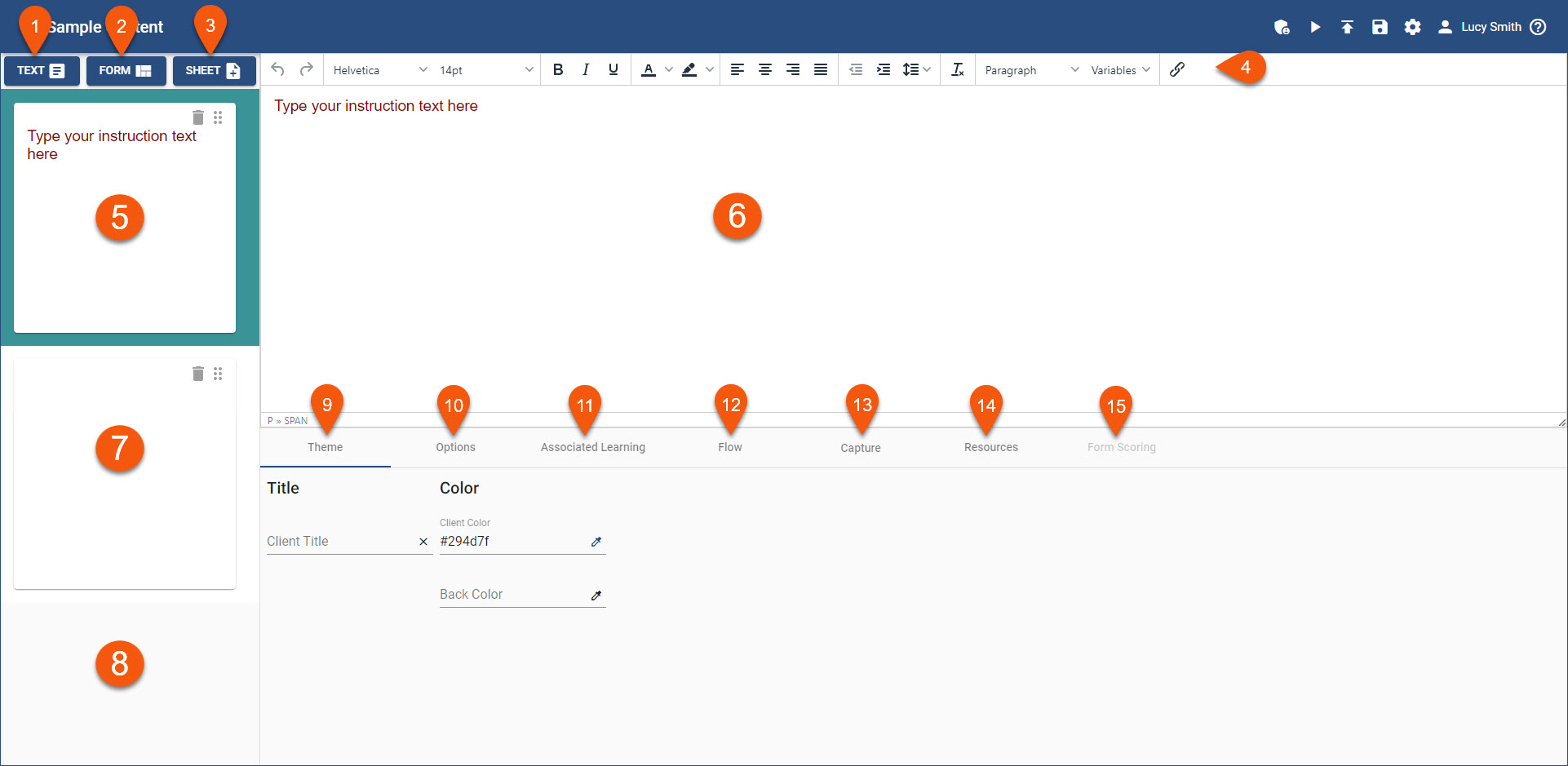The Content Editor is where instruction frames are created and formatted. The graphic shown below identifies the working areas of the Content Editor page. Both a Text and Form instruction frame have been created in an Assessment content file to activate all components of the page.

1.Click the TEXT button to create a text instruction frame. Text instruction frames can contain general information, tasks for users to perform, or resources such as graphics or links to resource items. Text instruction frames are also used for the title and closing instruction frames. (See the Using Text Instruction Frames topic.)
2.Click the FORM button to create a form instruction frame. Form instruction frames are used to create concept questions (i.e., multiple choice, true and false, or fill in the blank), gather user information, or confirm user acknowledgment of a firm policy. Resource items can also be included in form instruction frames. (See the Using Form Instruction Frames topic.)
3.Click the SHEET button to create a score sheet. Assessment content files can contain up to two score sheets: one for a passing score and a second one for a failing score. Using one score sheet for simply displaying the user's score can be used to inform users of their total score (confirming neither failing nor passing), and provide user access to their Results. The ScoreSheet dialog box provides the same text formatting toolbar, Edit pane, and access to Resource items as a Text instruction frame. Insert the Learners_Score variable where appropriate to display the user's score.
![]() The SHEET button is only visible in Assessment content files.
The SHEET button is only visible in Assessment content files.
4.Text Instruction Frame. The selected instruction frame is surrounded by a thick, teal border. Text entered in the Edit pane displays in the thumbnail. Gray icons in the top right corner of the thumbnail provide the option to Delete (trash can) or Move (domino) the instruction frame. When the mouse hovers over the Delete icon, the icon turns orange. When the mouse hovers over the Move icon, the cursor changes to a 4-headed arrow.
5.Form Instruction Frame. A sample form instruction frame that has been inserted, but not yet formatted. (See the Using Form Instruction Frames topic.)
6.Instruction list panel. As instruction frames are added to the content file, a thumbnail for each instruction is displayed in the Instruction list panel.
7.Text Formatting toolbar. The graphic displays the Formatting toolbar for Text instruction frames. The Formatting toolbar for Form instruction frames contains tools relevant to Form instruction frames. (See the Formatting Toolbar topic).
8.Edit pane. Type and format text in the Edit pane area.
Items 7 through 12 in the graphic are tabs which set the properties and add enhancements to both Text and Form instruction frames.
9.Theme tab. Settings on the Theme tab determine the instruction frame Title, Header bar color (which displays the Title and navigation Progress buttons/icons), and the background color for instruction text. Once set, these properties will automatically be applied to instruction frames inserted immediately below the active instruction frame. The Theme settings can be modified for individual frames. (See the Theme Tab topic.)
10.Options tab. Settings on the Options tab determine which content navigation Progress icons or buttons to display, as well as the location where the instruction frame should display on a user's monitor. Once set, these properties will automatically be applied to instruction frames inserted immediately below the active instruction frame. The Options settings can be modified for individual frames. (See the Options Tab topic.)
11.Associated Learning tab. The Associated Learning tab allow authors to name and create links to eLearning content and documentation supporting the instruction text. If the Show Results slider is active on the Content Settings Details tab, users can access to their score and results, users can access the learning links from their Results report. (See the Associated Learning Tab and Results topics.)
12.Flow tab. The Flow tab contains settings to control how and when to move content forward. Additionally, Section settings can be applied for Assessment purposes. (See the Flow Tab topic.)
13.Capture tab. The Capture tab launches the Capture Utility to capture the required step(s) for a user to perform in order to successfully complete the instructed task or action and move to the next instruction frame. (See the Capture Tab and Capture Utility topics.)
14.Resources tab. The Resources tab provides access to the Resource Library for inserting graphics, media links, etc., to the active instruction frame. Authors have the same ability to add or remove resource items in the Resources tab as in the Resource Library page. (See the Resource Library topic.)
15.Form Scoring tab. When a Form instruction frame is selected, the Form Scoring tab is used to set the scoring options for the selected instruction frame. (See the Scoring Form Instructions topic.)
![]() The Form Scoring property tab is only active in Assessment content files.
The Form Scoring property tab is only active in Assessment content files.
|